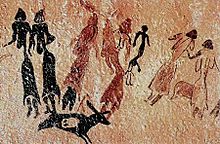Henri Breuil
Henri Édouard Prosper Breuil (born February 28, 1877 in Mortain , Manche , † August 14, 1961 in L'Isle-Adam , Val-d'Oise ) was a French prehistorian and a Catholic priest . He founded the research of rock and cave paintings and created the basis for the chronology of the Paleolithic .
Life
Henri Breuil entered the St. Sulpice seminary in Paris in 1895 . Through his teacher Jean Guibert he was introduced to the then still new ideas of the theory of evolution . He was ordained a Catholic priest on June 9, 1900, which is why he is commonly known as Abbé Breuil in France . He never held a parish office, but occasionally carried out casualies and spoke out on questions of the relationship between science and religion. His main occupation was scientific work, teaching history from 1905 at the University of Friborg (Switzerland) , from 1910 at the Institut de Paléontologie Humaine in Paris, and from 1929 to 1947 at the Collège de France . In 1938 he became a member of the Académie des Inscriptions et Belles-Lettres . In 1924 he received the Daniel Giraud Elliot Medal and in 1948 the Prestwich Medal of the Geological Society of London . In 1958 he received the Albrecht Penck Medal, awarded for the first time, for research on the Quaternary . In 1955 he was elected a Fellow of the Royal Society of Edinburgh .
Research into paleolithic art
Together with Louis Capitan (1854–1929) and Denis Peyrony (1869–1954), Breuil discovered murals from the Cro-Magnon period in the caves of Les Combarelles and Font de Gaume in the Dordogne department in 1901 . These prove that there was a highly developed art as early as 40,000 years ago. In 1902 Émile Cartailhac invited him to study the paintings of Marsoulas and Altamira . He then took part in the investigation of various sites in France, Spain and South Africa. In particular, he is the first prehistoric man to visit and describe the Lascaux cave . Many rock art got their names from Abbé Breuil and became known through his research. He copied the drawings in color by hand. These were then published in the specialist literature - including the “Dieu cornu” or “Magician of Les Trois-Fréres” ( Three Brothers Cave ), a man-animal hybrid (see also: Horned God ).
In 1912 Abbé Breuil inspected the cave paintings in the Cueva de la Pileta near the village of Benaoaján in Andalusia ; In 1913 he described the Cova de les Calaveres cave near the Valencian Benidoleig . His investigations, carried out between 1938 and 1939, of stone tablets from the Magdalénien with incised drawings of animals and people in surprisingly modern clothes, which were discovered in the cave of La Marche near Lussac-les-Châteaux . confirmed his theory that the people of the Stone Age must have been more developed than previously thought.

In the 1940s and 1950s, prehistoric art also took him several times to southern Africa and what is now Namibia , where he examined the rock art in the Brandberg massif , which had already been discovered in 1918, and interpreted one of the images as the " White Lady ". Today research is certain that it is a representation of a hunter or warrior, but the names " dame blanche " or " white lady " have survived to this day. Another mistake by Henri Breuil was the connection he formulated between black African rock art and ancient Cretan painting from early Greek times.
Publications
During his life, Abbé Breuil published over 800 shorter articles in various specialist journals. With his main work Quatre cent siècles d'art pariétal (1952), a compilation of the Paleolithic wall paintings from France known at the time, he achieved worldwide fame. This book is the result of more than 700 days of underground research. Above all, Breuil aimed at an accurate reproduction and description of the Paleolithic works and their dating.
Remarks
- ↑ See Alan Houghton Broderick: Father of Prehistory. (The Abbé Henri Breuil. His Life and Times). William Morrow & Co., New York NY 1963, pp. 129-142: Chapter 7: Breuil and Religion.
- ^ Biographical Index: Former RSE Fellows 1783–2002. Royal Society of Edinburgh, accessed October 12, 2019 .
- ↑ Léon Pales: Les Gravures de La Marche. Volume 1: Félins et Ours. Suivis du Félin Gravé de la Bouiche (Ariège) (= Publications de l'Institut de Préhistoire de l'Université de Bordeaux. Mémoire. 7, ZDB -ID 1125913-9 ). Ophrys, Paris 1969.
literature
- Jacques Arnould: L'abbé Breuil. Le pape de la préhistoire. CLD Editions, Tours 2011, ISBN 978-2-85443-551-1 .
- Arnaud Hurel: L'abbé Breuil. Un préhistorien dans le siècle. CNRS Éditions, Paris 2011, ISBN 978-2-271-07251-1 .
Web links
- Literature by and about Henri Breuil in the catalog of the German National Library
| personal data | |
|---|---|
| SURNAME | Breuil, Henri |
| ALTERNATIVE NAMES | Breuil, Henri Édouard Prosper (full name) |
| BRIEF DESCRIPTION | French prehistorian |
| DATE OF BIRTH | February 28, 1877 |
| PLACE OF BIRTH | Mortain |
| DATE OF DEATH | August 14, 1961 |
| Place of death | L'Isle-Adam , Val-d'Oise department , France |


